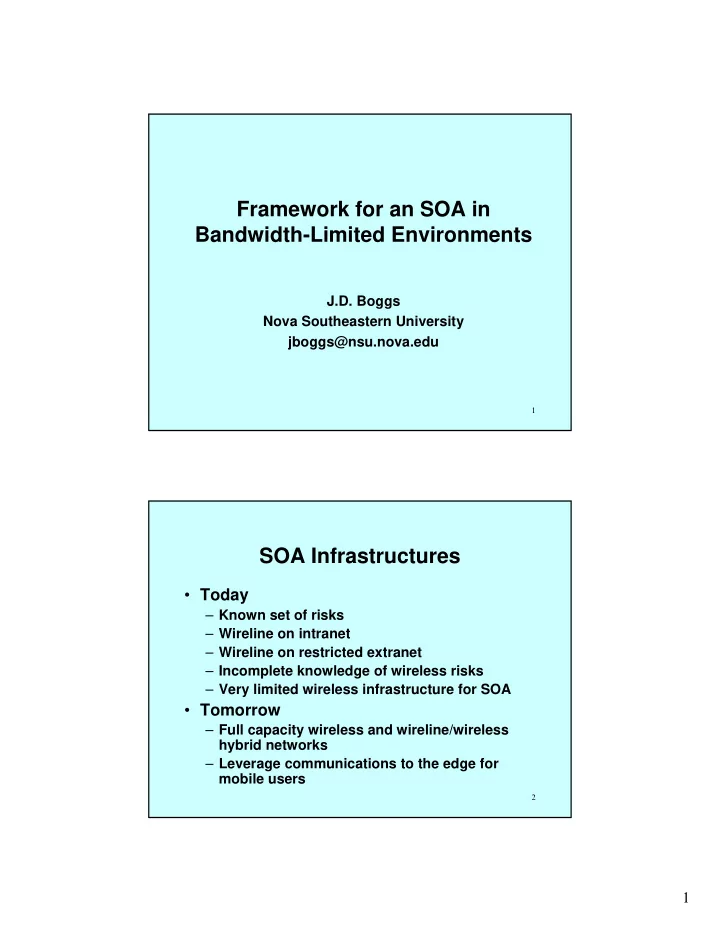

Framework for an SOA in Bandwidth-Limited Environments J.D. Boggs Nova Southeastern University jboggs@nsu.nova.edu 1 SOA Infrastructures • Today – Known set of risks – Wireline on intranet – Wireline on restricted extranet – Incomplete knowledge of wireless risks – Very limited wireless infrastructure for SOA • Tomorrow – Full capacity wireless and wireline/wireless hybrid networks – Leverage communications to the edge for mobile users 2 1
Mobile SOA Infrastructure Challenge • Beyond the fixed site edge – First Responders – Deployed Troops • Dynamic incident/objective area conditions – Dynamic terrain and obstructions – Bandwidth-limited capacity – Spectral interference and intermittent availability – Contended physical and spectral space 3 SOA Infrastructure Engineering Framework • Seven Steps to build infrastructure for mission Web services • Identifies technical planning issues in context of network disadvantaged users • Paper uses framework to highlight areas where research can be inserted in the design process 4 2
Framework Overview • Step 1 – Perform Opening Review • Step 2 - Define Engineering Alternatives • Step 3 - Perform Link Budget and Coverage Analysis • Step 4 - Perform Wireless Network Design • Step 5 - Perform Core Network Design • Step 6 - Sequence the Deployment • Step 7 - Administer and Maintain 5 Technical and Operational Challenges Mission Service Structure (SOA Design and Implementation) Response Payload size (min, median, max Mbytes) for 100% of know n service descriptions Expected service invocation (min, median, max) per hour Confidentiality requirement of coordination messages Invocation metod by service (including voice) Distribution of services by host (identify host and connectivity- either w ireline or w ireless) Service Message sizes and incidence Operational end-to-end response time required by service Redundancy of service hosts for continuity Registry approach (centralized or federated) Presentation addresses only 1 of 3 parts of Table 1 in the paper 6 3
Challenges of Step 1, Perform Opening Review • Examine Mission needs, security and defines services for the SOA • Capture consumer event and task sequences that invoke services • Determine invocation and response message sizes – SOAP or REST – Payload format • Consider XML – Growing ubiquity – Self-describing – Increased size – Processing on both ends of transfer 7 Efficient XML Interchange (EXI) • XML Increases file size – Typically 30% to 1600% increase after conversion – Dependent on data type, design and tools • W3C EXI Working group – Defined and tested XML alternatives – Released draft EXI Specification Dec 2007 • EXI Specification – File compactness – Processing efficiency – Applies to headers schema and data files – Reduces XML files from 4% to 75% – Dynamically adds production structures 8 4
Challenges of Step 2, Define Engineering Alternatives • Examine mobility Extent • Design specifications capture requirement interpretation • Registry and network information approach – Centralized/decentralized – Duplication/federation • Service Hosting • Reach back • Service instances on multiple nodes • Caching schema and references 9 Challenges of Step 3, Perform Link Budget & Coverage Analysis • Link modeling – Terrain and vertical obstructions – Available spectrum – Existing communications infrastructure – Utilities and RF environment – Invocation arrival and queue inputs – Protocol and propagation models – Mobility geometry • Coverage analysis – Connection handoff – End-to-end near optimization of interim results – Detailed region model with boundaries • Detailed plan for at least one alternative 10 5
Future Research 1.Cross-layer prototype with heterogeneous platforms in combatant/first responder scenarios 2.Define operational impact boundaries for using EXI 3.Define boundaries for repository caching 4.Define and test PKI for systems and services 5.Test the framework in an exercise 11 Conclusions • Engineers need a framework to deal with complications of wireless infrastructure for SOA in support of first responders and deployed troops • Generating the framework, validating supporting models, and generating effective infrastructure designs is difficult work • We have to start now 12 6
Recommend
More recommend